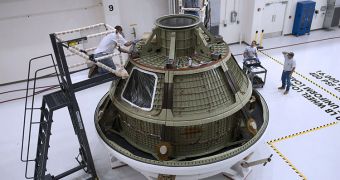Officials at the American space agency announce that the Orion Multi-Purpose Crew Vehicle (MPCV) successfully completed another parachute drop test, on Wednesday, July 18. The event holds the entire project on course for an early 2014 launch to orbit
The new assessments were conducted above the US Army's Yuma Proving Ground, in southwestern Arizona. An Orion engineering unit was dropped from a Boeing C-17 airplane, while the latter was traveling at an altitude of 25,000 feet (7,620 meters).
According to engineers, the Orion mock-up used in this investigation mimics the full size, shape and weight of the spacecraft that will actually fly to space. While several parachute drop tests have already been conducted, this was only the second to feature this vehicle.
When completed, the MPCV will be able to carry up to 7 astronauts, and will be used to reach the surface of a near-Earth asteroid by 2025, and the Red Planet by the early 2030s. During these extensive travels, the vehicle will be able to ensure the safety of its crew.
After the Orion was dropped from its carrier airplane, its drogue chutes were the first to deploy, at altitudes between 15,000 and 20,000 feet (4,572 and 6,100 meters). The drogue chutes were promptly followed by the pilot parachutes, which then triggered the release of the main landing parachutes.
The spacecraft impacted the ground at a speed of 25 feet (7.62 meters) per second, which was well below its maximum allowed impact velocity. In other words, the vehicle performed admirably during its latest test.
“Across the country, NASA and industry are moving forward on the most advanced spacecraft ever designed, conducting drop and splashdown tests, preparing ground systems, designing software and computers and paving the way for the future of exploration,” William Gerstenmaier explains.
“Today's parachute test in Yuma is an important reminder of the progress being made on Orion and its ultimate mission – enabling NASA to meet the goal of sending humans to an asteroid and Mars,” adds the agency official.
Gerstenmaier holds an appointment as the associate administrator of the NASA Human Exploration and Operations Mission Directorate, at the agency's Headquarters, in Washington DC.
NASA will launch the first (unmanned) Orion space capsule in 2014. Upon existing the atmosphere, the vehicle will move to an altitude of around 3,600 miles (5,794 kilometers), which is around 15 times higher than the average orbit of the International Space Station.

 14 DAY TRIAL //
14 DAY TRIAL //